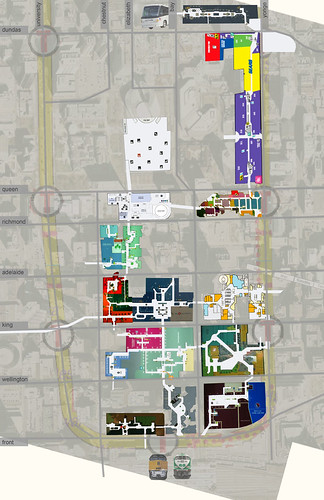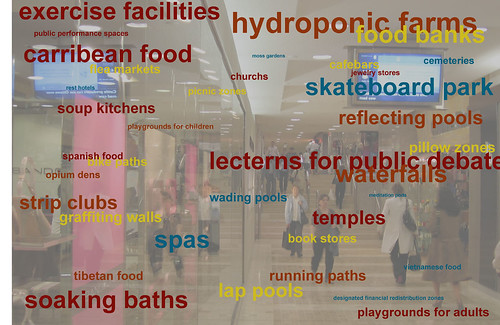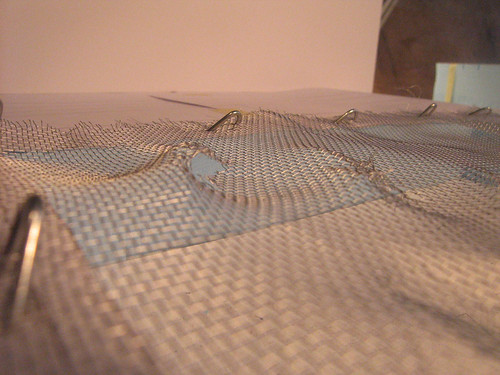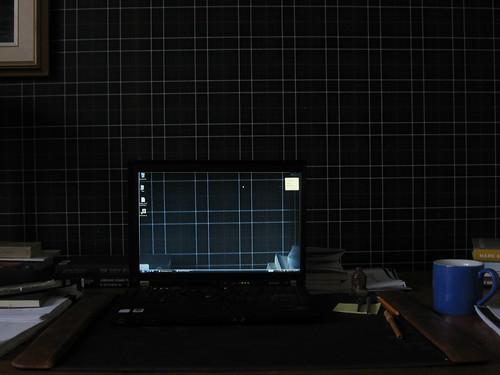
12.25.2008
More on Interface Blending

Disintegration of the Interface

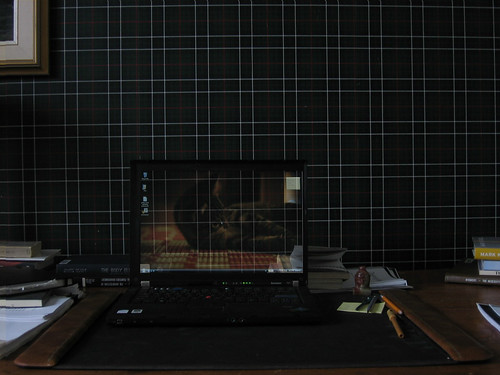

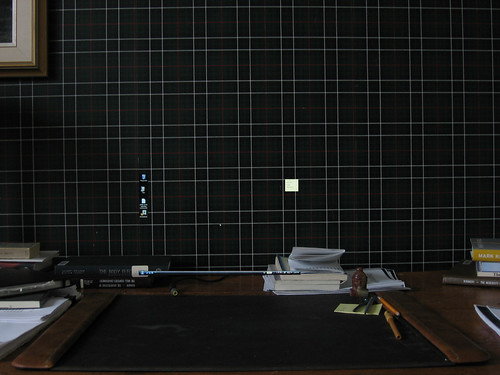

Frankly I find the images pretty uncomfortable, but that's part of what I find fascinating about the subject matter.
12.16.2008
Architecture as Law
To what extent may the physical construction of the world we inhabit constrain our actions, similar to law?
It is often said that architecture gives form to life. This occurs both by crystallizing our values in form, and also in the canalization of our activity. For an example of the first you need reach no further than any monumental architecture, be it the temples of ancient Rome or the courthouses and parliaments of the 19th and 20th centuries. The second way in which architecture controls is more subtle. For an example, think about the difference between a 19th century compartmentalized house and a late 20th century ‘open-plan’ house: the Victorian house is far more prescriptive in how it is used – it controls your use of the house by literally guiding your body through it.
In Lawrence Lessig’s book, Code (1999), in which he attempts to demonstrate how the construction of the Internet subtly, and sometimes not-so-subtly, controls our use of it, he references architecture’s operational affinity to law parenthetically as a sort of proof by analogy. He offers several examples. Robert Moses’ bridges to Long Island were intentionally built too short to allow buses (and thus ‘undesirables’) through. Speed bumps demand (more or less effectively) a certain type of behaviour from people, thus enforcing the will of the ‘designer’. Locked doors, of course, are an obvious and simple example of controlling access, as are guard rails, etc. These are all examples of architecture operating as a sort of law – exacting a certain behaviour from people through the design of the physical environment.
Examples like the speed bumps and the bridges are of course only architecture in an expanded sense of the word, but can we not imagine similarly a floor surface designed to make people walk slower (of foam maybe?), or a door that was very small and thus only allowed a certain dimension of person through! We could also imagine a chair that only fit a certain size of hip. If you were not the right shape, you would be “architecturally” prevented from sitting in the chair. Although this sounds fanciful, it happens on a regular basis. Chairs are always designed for a specific range of the population. Think of seats at the cinema– they’re all the same size, but we aren’t. A very short person can’t see over the seat in front of them – a very large person won’t fit between the arm-rests. Benches are great largely because of their flexibility – you can sit, or sprawl, or lie down. One person could use a bench, or several – and it doesn’t matter the size of your rear end. But many public benches now have small ‘nubbins’ on them that are there specifically to prevent you from lying down. The design of these benches is at the service of the authorities, operating as a form of law.
But there is another example of chairs operating in this way which is less obvious: think of Corb’s ergonomically-designed seat in the bathroom of Villa Savoye. In that this seat is specifically designed to match a person’s body, in its very ‘humanistic’ customization, it is actually exclusionary! This observation, that customization has the capacity to be exclusionary, opens up a very interesting question. Could humanism in architecture, and I’m thinking specifically here of the ‘phenomenological’ approach propagated by Holl and Pallasmaa amongst others, not actually be dangerous in its very specificity? The double-edged blade of phenomenology is that it by necessity is highly personal, and thus has the danger of being both narcissistic and exclusionary. The power of the search for the ‘things-in-themselves’ lies in its situation in experience, but that experience is always personal. This sort of design has the capacity to be exclusionary in the same way in which the philosopher Albrecht Wellmer has spoken about the impulse towards ‘regional’ styles in architecture. This sort of neo-conservative thinking about territory, he has pointed out, while strengthening inclusion and ‘grounding’, simultaneously excludes. In the same way that Moses’ bridges prevented certain people from getting to Long Island, does regionally-styled architecture not exclude those who, by virtue of geographical origin, don’t ‘get it’?
Security cameras too are a form of architecture acting as law, and not because of their actual use to record things. Security cameras in reality serve primarily a symbolic function, as everyone knows: reminding would-be offenders of the powers that be. They are almost a form of ornamentation, iconographically representing the power of the nation state (or corporation) just as statues of angels and demons used to remind us of the powers of good and evil.
Which of course brings us to Jeremy Bentham, the great Utilitarian philosopher, and his famous excursion into architecture. The genius and effectiveness of Bentham’s single (as far as I know) architectural foray, the Panopticon, continues to strike terror into the hearts of theoreticians of architecture to this day. It symbolizes the power of architecture, in the service of authority (as it always is, don’t forget), to reduce people through fear, to humiliate and tame them through exposure.
plan of panopticon by J. Bentham, from wikimedia commons
Architects like to speak rhapsodically (and hubritically) of their power to influence people through architecture. There is an enduring belief in the field that architecture can change the world, the lurking spectre of a modernist idealism that is not yet spent. Architecture can indeed, as Lessig points out, operate as a sort of law. And in the same way that it disables a fat person from using a narrow door, it can enable a person who has lost the use of their legs to enter and explore a museum. Ramps and elevators help people with disabilities get around buildings. Railings prevent people from falling off of balconies. Small bumps on walls allow people without the use of their vision to locate certain rooms. But there is a darker side to all of this as well. Regionalistic architecture includes those that belong, but potentially excludes outsiders. Gothic churches both inspired hope and struck fear into the hearts of the faithful. Humanistic architecture implies a definition of humanity. Ornamental security cameras both reassure people and reinforce the power of an abstract and dis-embodied authority.
12.12.2008
PATH Redux

Spacing Magazine recently ran a competition called ThinkToronto in which young designers were asked to present their vision for some aspect of Toronto's future. Now that I know for absolutely sure that my design was not selected (the names were officially announced on Wednesday) I feel I can post it here.
The text interspersed with the images is the text that I submitted with the competition. In retrospect I realize that it probably sounds a bit radical. This is a different breed of project from those that actually won the competition, both in its criticality and in its lack of refinement.
All the images appear to be getting cut off - so if you're interested please click on them to see them in full.
** collage diagram showing current configuration
Healthy democracies derive their strength and flexibility from an active and dynamic public sphere. This kind of public sphere finds its clearest manifestation in the sort of public space that allows for free encounters and dialogue between citizens. This project entails a radical rethinking of the PATH system as a new subterranean network of public space, one that allows for collisions of difference – engagement between citizens from all segments of society, unfettered by the homogenizing pressures of consumerism.
This proposal creates a new zone in the city where people want to go, and can go year-round, not only to shop, but to be: to relax, to talk, to engage politically, to engage culturally, to perform and to spectate, to exercise their bodies, and to expand, focus, problematize, and engage their minds.
** diagram showing some possible programs that could be associated with the PATH
The current configuration of PATH is predicated upon and supports a limited and exclusionary vision of what it means to be human. The new PATH operates outside of this paradigm, inviting citizens to display openly their stories, traditions, habits and beliefs, and offering new possibilities for experiencing difference -- a key building block in constructing a tolerant, pluralistic society. Public space is about this sort of engagement. A redefinition of PATH would provide a massive infusion of viable public space, usable throughout the year, into the heart of downtown Toronto.
As a first step, the City of Toronto is required to expropriate a large portion of PATH. Although extensive, this expropriation is confined to the connective tissues that currently link the commercial enterprises. Not performing this acquisition would be equivalent to trying to plan a city in which not only the buildings but the sidewalks, the roads, and the parks were all owned by private companies. The expropriation is thus necessary in order to implement a comprehensive subterranean urban plan.
** Maps showing existing conditions and interventions
As primary nodes in this new subterranean urbanism, a handful of undergrade parks, or ‘unterparks’, are to be established. Three suitable candidates for this purpose are immediately apparent: the parking garage under Nathan Philips Square, the parking garage under Yonge-Dundas Square, and the ‘moat’ that lies between Union Station and the adjacent subway station. The future for which this PATH is envisioned is one without the need for cars in the downtown core. Unterparks are large, diverse zones including market-spaces, exercise spaces, skateboard parks, moss gardens, community pools, etc. In the cases of both the current parking lots deep incisions are necessary to allow natural light in. At Nathan Philips Square, for instance, the reflecting pool could become a waterfall with water streaming down into another pool below.
After the unterparks, a series of smaller public spaces are to be established, called ‘subsquares’. These are mainly repurposed from existing foodcourts, but are significantly redefined. Instead of fast food chains, affordable restaurants and cafés are encouraged with individual seating. Subsquares are places to meet, to rest, to enjoy the performance of a busker, or to have a picnic on the steps of a fountain.
The third element of expropriation is then to establish a clear network of underground boulevards, or ‘substreets’. The substreets will provide connections between the unterparks, the subsquares and the primary transit nodes. These are pedestrian promenades, both intended to channel commuters to and from their places of work, but also for people to generally enjoy walking along – to see and be seen, not like the Ramblas of Barcelona. The proposed substreets are considerably wider than most of the current corridors in PATH. Generally they are to be eight to twelve metres wide, allowing both for a generous thoroughfare for pedestrians and also room for street furniture on the side.
** Nathan Philip Square parking garage becomes a market, with perforations above to introduce light
Beyond these acts of expropriation, the remainder of the PATH shall continue to be privately owned, including all of the retail space off of the primary public areas. Generally, however, it is recommended that the current owners sell the retail units as condominium units, so that tenants may own the property instead of just renting. This will increase the diversity of shops and programme available in PATH.
Some simple strategies for increasing the likeliness of direct public encounter and dialogue include ‘graffiting walls’ and public stages and lecterns. Graffiting walls are chalk-board walls complete with chalk where people are encouraged to air their issues and grievances, in the manner of the medieval ‘talking statues’ of Rome or also in the manner of bathroom graffiti. The public stages and lecterns are to be used for speeches and public debates like ‘speaker’s corner’ in London but also they are to be used as stages for both impromptu and organized performances.
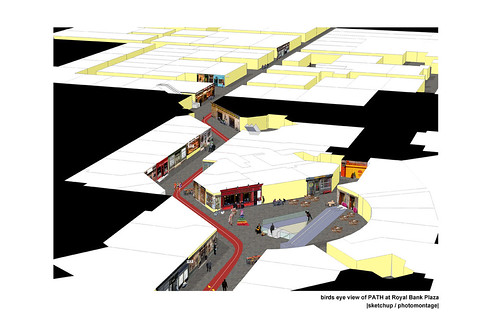
** Cut away perspective image demonstrating some potential moments from the proposed new PATH
11.08.2008
Google Books News
the link is here:
http://www.nature.com/news/2008/081105/full/456014d.html
Google just settled a suit with the Authors Guild (of America? not sure) giving them a great whack of cash in compensation for all of the books that Google has been scanning without the authors' permission. In the future, the authors will receive a portion of the money raised by the GoogleBooks site.
More important however, are the other aspects of the deal. In the future, libraries will be able to subscribe to GoogleBooks, allowing anyone within the library system access to the full book online. For us at universities, this means as long as we are logged onto our computers through the university 'node' we will have complete access to this vast wealth of information in a real-time, text-string-searchable manner. To take a quick example, let's say I am reading something about Foucault and suddenly find myself wondering what his opinion was of Gilles Deleuze. In moments, I could easily search all documents by Foucault for their references to Deleuze. Just like that. I would have an answer to my question in less than 10 minutes! Further, Google will be opening this vast array of data to researchers and 'data-miners' who will be able to excavate all kinds of interesting information from the data-set in-toto!
I think GoogleBooks (and the other associated and similar initiatives) is (and are) a great gift to humanity. Digitizing this information is greatly changing our relationship with it - how we understand and use it - and will continue to change it in ways that we can hardly understand yet. But for now I cannot foresee the negative consequences and I am thus absolutely in favour of these changes. Bravo Google!
update - 08-11-10 -
The news just hit the New York Times. Apparently, according to their story, the deal focuses primarily on books that are still under copyright but are out of print. This is of course a great thing for publishers who normally have no way of making money off of books that are in their catalog but are not in print. As the editor of The Bookseller apparently said, "Almost overnight, not only has the largest publishing deal been struck, but the largest bookshop in the world has been built, even if it is not quite open for business yet"!
9.25.2008
PATH Photodocumentary
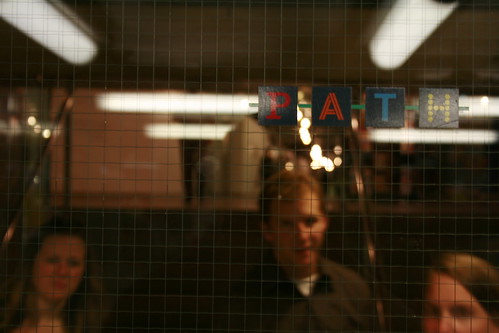
For a while now the PATH system of underground corridors and retain stores has been of interest to me. It's a fascinating idea! Whether you're reading it from a Jungian standpoint, a neo-Marxist perspective, or you just like to look at people, there is an almost inexhaustible amount of food for thought in this underground city. I took some time recently to fully explore the system and attempt to capture some of its moments with my camera.

The PATHway from the Eatons Centre to Bell Trinity is a beautiful 1970's essay in diffused lighting and materials.
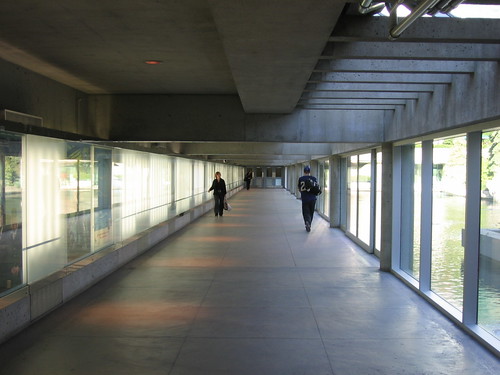
This is one of the finest moments in the PATH, at Roy Thompson Hall.

This is underneath Mies Van der Rohe's TD towers.

The retail in the PATH seek to satisfy the every need of these harried commuters: music, food, new shoes, flowers, jewelry, books, magazines, coffee, etc. etc. . .
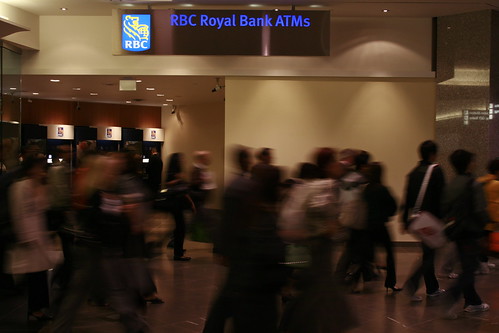
From the suburbs on the GO train to the station through the corridors, fill up your coffee cup at the Starbucks, fill up your wallet at the ATM, up the elevator to the office. Down again at 10:00 for another coffee. Which food court should we go to today for lunch?

Commuters running for their trains at Union Station

Fake birds and plants at the Eatons Centre

A place for emergence - natural light enters the PATH
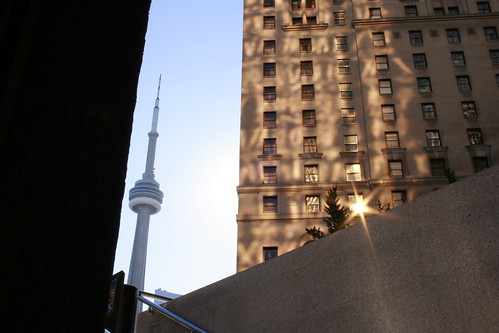
A view out.
8.21.2008
Bruno Taylor adds fun to public furniture!
The photos are from a Pixelsumo article:
Yest, a bouncy park bench! The seat is supported entirely by two large spiral-springs.
A bus stop in London. I feel inspired to finally continue a long abandoned project I had for a subwaycar swing - watch for it here over the next couple months.
6.17.2008
M1 Unstable Topographies Project
In contrast to the chaos of life in the street, the building has a blank serenity to it. A scattering of windows reveals an internal logic, but the rough, board-form concrete wall is largely silent as to what lies behind it. In the bottom left hand corner there is a large opening that seems like it will allow passage, so I approach. Beside this opening, a small sign confirms that this is in face the art gallery that I am looking for. I pass through the aperture into a relative darkness. My eyes take a short while to adjust, but soon I realize that besides the small door to my left, the only option is to continue forwards, down a large, wide ramp. I feel my descent registered in my feet, in the ceiling above my head, and against the small horizontal shelves projecting from both walls. When I begin my descent the shelves are on level with my foot, but by the time I reach the bottom, the shelf is now at the level of my head.
After this dramatic, lonely descent, I discover a small office with a woman inside. I ask her how much it costs to view the collection, but she just waves her hand - the gallery is free. I am in a tall, narrow, corridor, ramping upwards. Above my head a long horizontal opening without glass allows light and air into the space, but it is too tall for me to see out of it. A break in the concrete wall on my left gives way into a large room, which I enter. Displayed here are a few select pieces of sculpture. In the centre is a small octagonal pool of still water. Light penetrates the room through a series of translucent, diagonal slash-windows, all aligned to form a band of light, circling the room, cutting upwards across the walls. While the room is square, above my head it fragments into an octagon through a series of four triangles, and then further into a circle which supports a concrete, domed ceiling. In the centre of this ceiling is an oculus, lined in a dark, yellowy wood.
Leaving this quiet room, I move up the corridor to the first gallery displaying paintings. A small plaque informs me that this is the oldest part of their collection, showing their most established works. I pause particularly before a very nice, small work of Rossetti’s. It sets a nice, rather romantic mood to the room. Leaving the gallery by the door I entered, I continue up this ramped corridor, which appears to be wrapping around the sculpture gallery. As I proceed upwards, I move closer to the band of light which was originally above my head. I visit another painting gallery, similar to the first, also off of this corridor, and eventually I end up at level with this band of light and I can see through it. A square space, open to above, is revealed, bounded on each side by a wall punctuated by columns. There is only one entrance to this space, and in the centre is an octagonal, wooden seat. In the centre of this seat is a circular hole that seems to be the oculus that I saw before, but from the other side. I enter the space and approach the wooden seat. It is lovely feeling the sky above my head. A logia wraps around this court-space, above.
I now find myself in a large, ramped gallery with paintings hanging from the walls. From the top of this gallery, a smaller ramp, leading to the right, brings me into yet another gallery, now showing an increasingly contemporary collection of paintings. Off of this gallery I find the logia I saw before. I take a moment to gaze down upon the court-space. It looks serene - the green of the grass and the soft yellow of the wood stand out against the rough foil of the concrete.
I find my way up a narrow enclosed ramp, lured by a broad picture-window at its summit. The walls on either side are punctured by small translucent windows. Turning around at the top of this ramp, two large glass doors open onto an exterior ramp that leading apparently to a roof terrace. Two shelves, like before, register my ascent, this time beginning at the height of my head and ending at the level of my feet. On the terrace, I drift about for a bit. There is a raised platform to one side, which I approach. I step up onto the platform and absently lean against the low wooden railing, looking down. From this plateau the activity in the street below seems deceptively comprehensible. Eventually I turn back to the terrace and begin my descent.

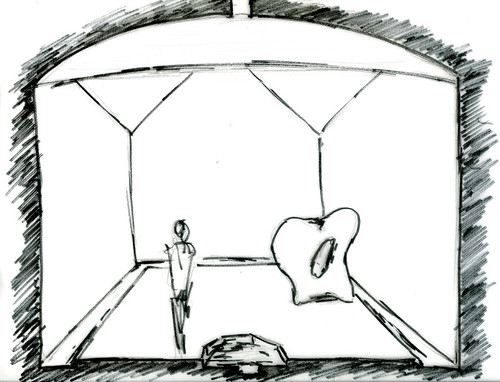

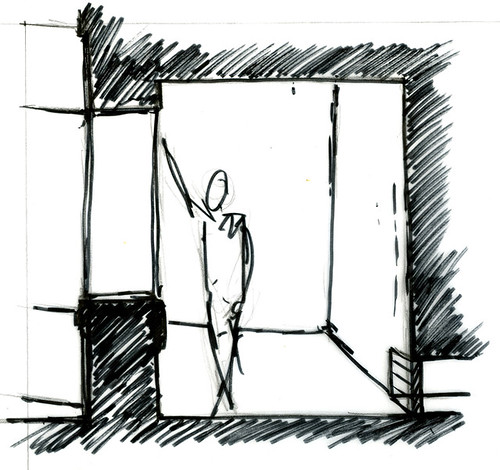

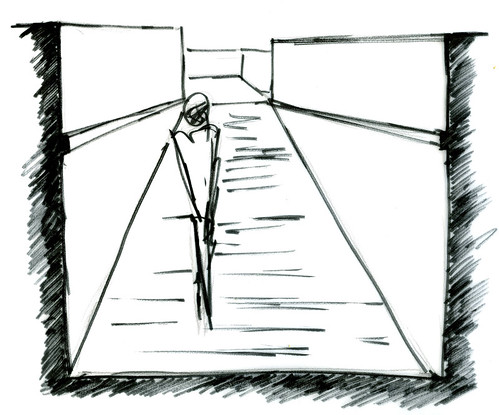
M1 Uncanny Inhabitations Project
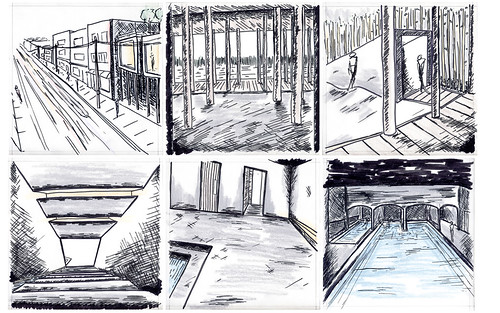


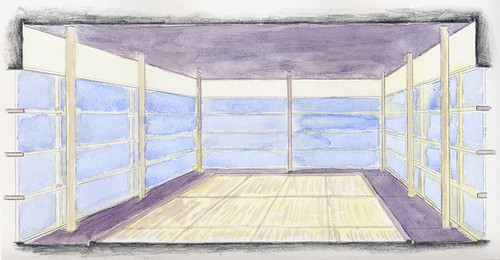


5.16.2008
Pics from Barcelona @ untimelyfabrications
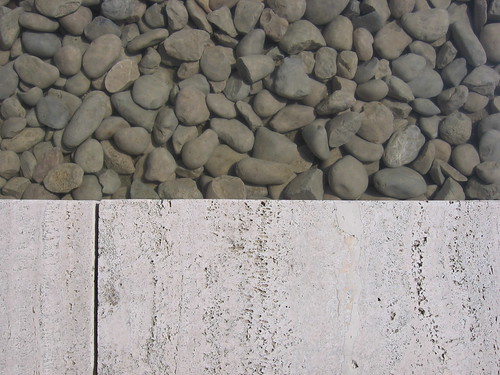
I have just posted a series of photos from my recent trip to Barcelona to the studio blog, untimelyfabrications.blogspot.com
4.24.2008
Photographs from Trip to Palermo
Palermo is a beautiful and strange city, it contains a palimpsest of old Italian architecture layered with the Islamic architecture of the Saracens further layered with 12th century Norman influence, a breed of distinct Islamic-Norman-Italian architecture that can't be seen anywhere else. The landscape of Sicily is rugged and picturesque, clearly informed by its volcanic origins. Nearby, in Segesta, we visited an ancient Greek temple, dating I believe from the 6th C BC.
Enjoy the photos!
4.23.2008
Hi Ho, Hi Ho . . .
3.26.2008
Working Site Model - Ground Play - (un)Canny Inhabitations
3.23.2008
Pictures from Around Rome - 08-03-23

There is an exhibition on at Trajan's Market displaying the work of Japanese-Italian sculptor Kan Yasuda. His objects, large smooth sculptures in stone, are especially uncanny in relation to the rough brick and stone of the market. His work seems atemporal, perhaps because of their general lack of referentiality, which contrasts powerfully with the perceived historicity of the market.
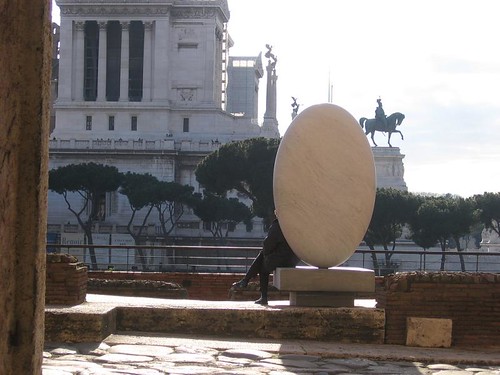
This temporal perplexity persists - here the timeless sculptures contrast against the rough hewn quality of the very old market, but also against the historical faux-historicity of the Monument to Vittorio Emanuele Due.

The sky, framed behind the Baths of Diocletian
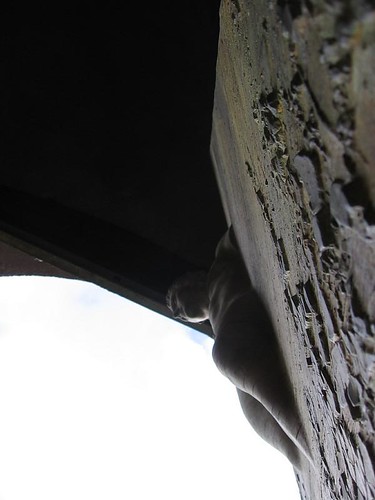
One of the bronze doors to the Baths of Diocletian, representing martyrdom
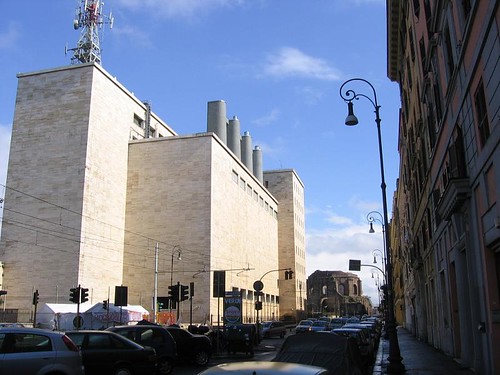
Rome can always be counted on to present strange vignettes such as this one.

Myself, Christina, Ryan (visiting from London), Ryszard, Shane, Jeff & Bri (visiting from Victoria) eating out on the street in Trastevere. The restaurant was too full to accomodate us, so they set up a table outside.
